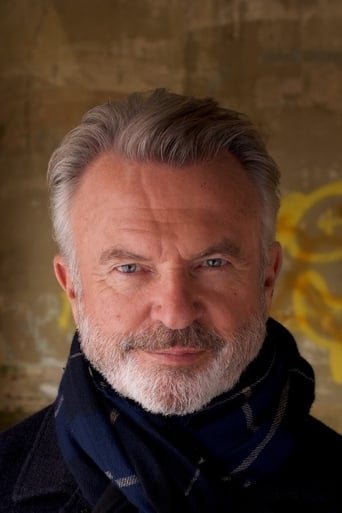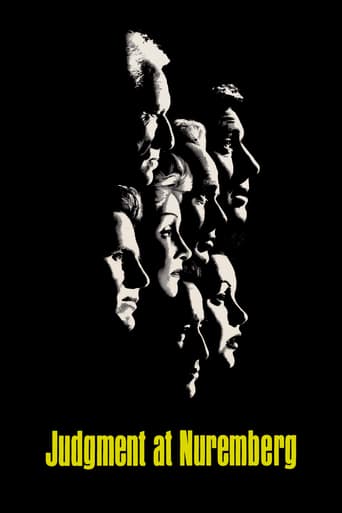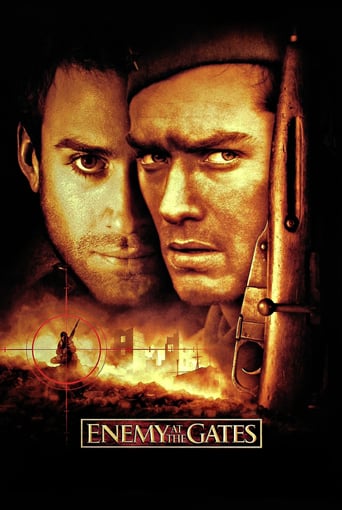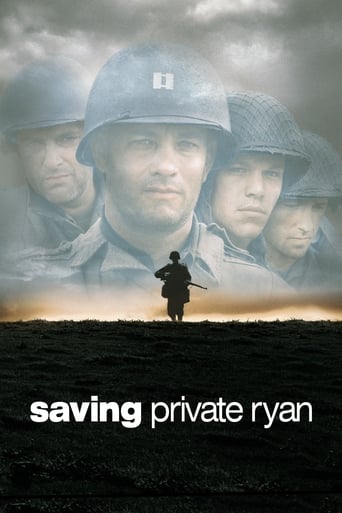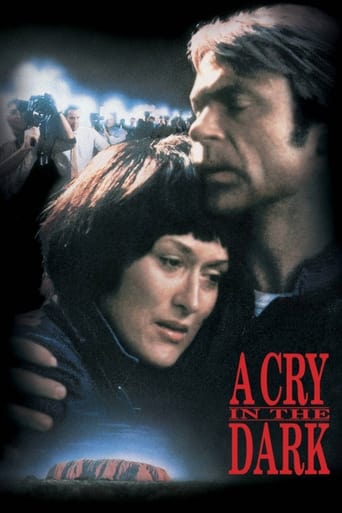

Evil Angels (1988)
Based on the true story of Lindy Chamberlain who, during a family camping trip to Ayers Rock in central Australia, claimed she witnessed a dingo take her baby daughter, Azaria, from their tent. Azaria's body was never found and, after investigations and two public inquests, she is charged with murder.
Watch Trailer
Cast
Similar titles
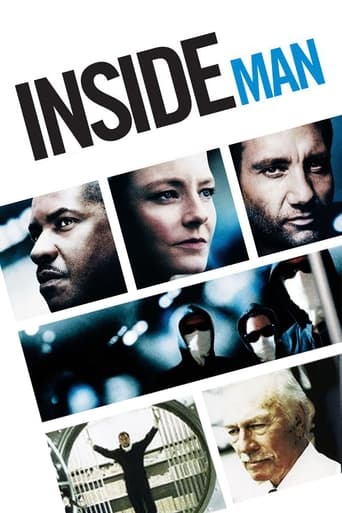
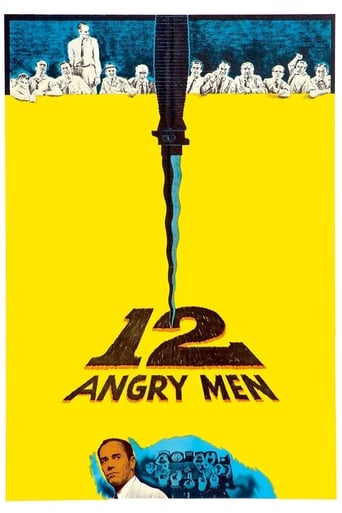
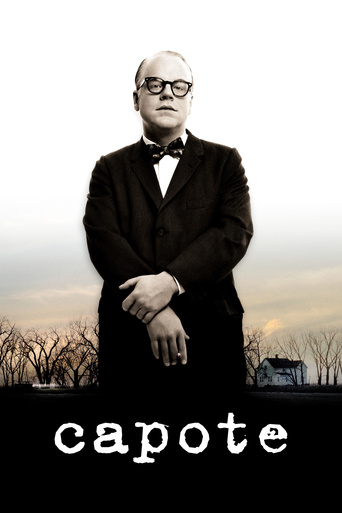
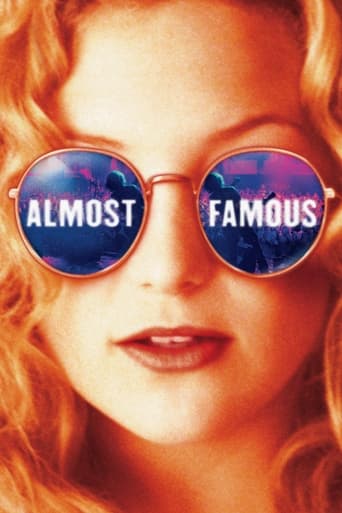
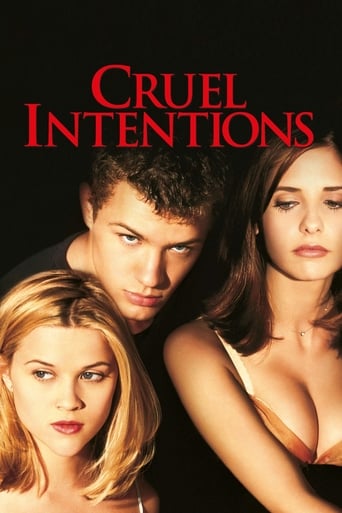
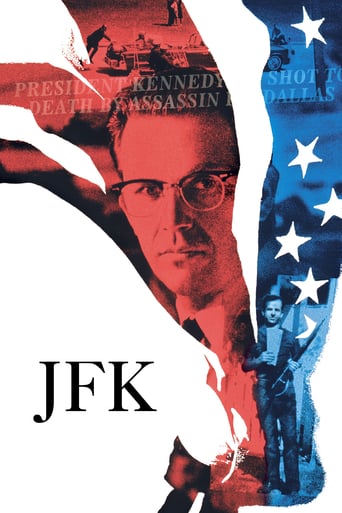
Reviews
Good story, Not enough for a whole film
When a movie has you begging for it to end not even half way through it's pure crap. We've all seen this movie and this characters millions of times, nothing new in it. Don't waste your time.
The film's masterful storytelling did its job. The message was clear. No need to overdo.
Story: It's very simple but honestly that is fine.
A contemporary, and classic, tale of injustice.Evil Angels, aka A Cry in the Dark, depicts the famous case of Azaria Chamberlain, a baby killed by a dingo near Ayers Rock / Uluru in 1980. Due to the sensationalist, libelous and slanderous nature of the Australian media and the evidence-manufacturing abilities of the Northern Territory Police the mother of the baby, Lindy Chamberlain, was charged with the baby's murder. What follows is a frustrating and harrowing ordeal, for the accused and for the viewer, as you are lead through the travesty that was the court case.Many themes are covered, none of which show Australian society in a positive light. Shows just how despicable the Australian media are - sadly, they're even worse now (95% of what you see or read in Australian media is sensationalized bs). Shows the incompetence, even corruption, of Australia's police forces, particularly in the Northern Territory in the 1980s. Shows how the media can influence a trial, and how far-from-optimal the jury system is. How the jury reached a unanimous guilty verdict is beyond me.Also shows how the media get the average yobbo caught up in someone else's affairs - the trial had nothing to do with them.Great performance by Meryl Streep in the lead role. She totally nails the accent (which is more than one can say for most Hollywood actors faking an Australian accent) and seems immersed in the role. She well deserved her Oscar nomination.Sam Neill is OK as Michael Chamberlain. The bit-part Australian actors often leave a lot to be desired, however, overdoing the redneckness.
In August 1980 a nine-week-old baby girl named Azaria Chamberlain disappeared from a camp-site near Ayers Rock, Australia. The baby's mother Alice (generally known as Lindy) stated that her daughter had been taken by a wild dingo, and a subsequent inquest ruled that her account of events was true. That, however, was not the end of the matter. The police continued to investigate the disappearance, and eventually Lindy was charged with Azaria's murder; her husband Michael was charged with helping her dispose of the body. In October 1982 both were convicted and Lindy was sentenced to life imprisonment. (Michael was only given a suspended sentence). Several years later fresh evidence came to light which led to Lindy's release from prison; in 1988, shortly before this film was released, both the Chamberlains were acquitted by the Northern Territory Court of Appeals of all the charges against them.The "dingo baby case", as it became known, was one of the most controversial cases in Australian legal history. I remember an Australian friend coming to visit me in the early nineties, several years after Lindy and Michael Chamberlain had been exonerated, and as like me he was a keen film enthusiast I suggested that we should watch "Out of Africa" which was on television that evening. He refused point blank, stating that ever since the release of "A Cry in the Dark" he had made it a principle not to watch any film starring Meryl Streep because of what he described as her part in the "whitewashing of a notorious child-killer". My friend's attitude was by no means unusual in Australia. The case divided public opinion sharply in that country, with the majority probably believing that the Chamberlains were guilty. Gossip about them was widely repeated and quickly accepted as the truth. One thing that even the prosecution was unable to come up with was a plausible motive for the alleged crime. Those, however, who wanted to see the Chamberlains prosecuted in the court of public opinion were not so reticent. The couple were members of the Seventh-day Adventist Church- indeed, Michael was a pastor in that church- and rumour soon had it that Adventist religious doctrine demands the human sacrifice of young children in order to atone for the sins of the community. It was also widely, and incorrectly, reported in the media that the name Azaria means "sacrifice in the wilderness". Few of those who passed on these rumours had any real interest in Adventism, or how the doctrines of that church differ from those of mainstream Christianity; they merely saw the church as a bizarre and fanatical cult. This was the second film directed by Fred Schepisi in his native Australia. His first film, "The Chant of Jimmie Blacksmith", also based on a real-life murder case, was part of the Australian "new wave" of the Seventies, but soon after making it Schepisi left for Hollywood. It is a dry, factual look at the facts of the case in the manner of a television docudrama; there is little to distinguish it from a "based-on-a-true-story" TV movie except for the presence of a major international star in the shape of Meryl Streep. (That and the fact that it is more factually accurate than most TV movies). Streep gets a chance to add another to her collection of accents, having earlier in the decade bagged British ("The French Lieutenant's Woman", "Plenty"), Polish ("Sophie's Choice") and Danish ("Out of Africa"). (Some people still think of her as an actress whose main skill is the ability to reproduce foreign accents, even though since the end of the eighties she has rarely played characters who are not American, her Italian-born housewife in "The Bridges of Madison County" and Margaret Thatcher in "The Iron Lady" being the main exceptions). Here she gives an excellent performance as Lindy Chamberlain. What is so remarkable is that she is able to convey not only her Lindy's strength of personality and belief in her own innocence but also the character traits which persuaded many people that Lindy was in fact guilty. Meryl was nominated for a "Best Actress" Oscar but lost out to Jodie Foster in "The Accused". What alienated so many members of the public was Lindy's refusal to make a show of her grief and her calm demeanour and stoical acceptance of her daughter's death. This attitude was probably based on Lindy's firm religious beliefs, her conviction that Azaria's death was the will of God and that her daughter had gone to a better life in Heaven, but many people took it as cold-heartedness, even as proof of her guilt. Sam Neill is also good as Michael, a weaker character than his wife, who confronted with disaster loses faith both in God and in Lindy's innocence. "A Cry in the Dark" has many similarities to a number of British films from around this period dramatising real-life miscarriages of justice, such as "Dance with a Stranger" and "Let Him Have It". Films of this nature, quite apart from their entertainment value, also have a useful social function in that they remind us of how easily such miscarriages can occur. In Lindy Chamberlain's case the main factors appear to have been public hysteria, prejudice against a minority religion, the irresponsibility of parts of the media and flawed "expert" evidence. (Azaria's clothing was examined by a British forensic scientist with no knowledge of dingoes; a chemical sprayed on the Chamberlains' car as a sound deadener was mistaken for blood). That the Chamberlains were eventually exonerated was largely due to the chance discovery of new evidence; one wonders how many innocent people are still in jail waiting for such evidence to turn up. 7/10
It was one of the most intriguing mysteries of the twentieth century. On 17 August 1980, Lindy and Michael Chamberlain were on a family camping trip to Uluru (Ayers Rock), when their nine-week-old daughter, Azaria, disappeared. The couple maintained that she had been taken by a dingo, but circumstantial evidence, which included Lindy's confrontational personality and the family's religious beliefs, led to the perception within Australia that Azaria had been murdered by her mother. As many readers will know, Lindy was convicted of the crime after a trial that received unprecedented media coverage (rivalled only by Madeleine McCann's disappearance in 2007) and served three years in prison, before new evidence emerged which exonerated her.Hearing the news this morning that, at long last, an Australian coroner has served the Chamberlains with a death certificate confirming that Azaria was killed by a dingo, reminded me of how brilliantly the family's struggle for justice was portrayed in A Cry in the Dark.Quite often, the courtroom drama, so popular in the 1980s, can be a very formulaic film genre. The undoubted tension of real-life courtrooms rarely translates into exciting films; some exceptions being, I believe, Primal Fear (1996) and Jagged Edge (1985). The success of those films, like that of A Cry in the Dark, is chiefly down to their having an eerie, highly ambiguous mystery at their hearts which keeps the audience gripped. Indeed, Fred Schepisi's film focuses on conversations between anonymous characters throughout Australia in order to reflect the circus-like attention the Chamberlain case received.Meryl Streep's performance is key to maintaining the central ambiguity. In the film, Lindy is both a common housewife who is simply determined to prove her innocence and a potentially sadistic murderess. Despite your sympathy for her, the nagging doubt that Lindy might be guilty persists until the final scenes, and this prevents A Cry in the Dark from becoming predictable - even though you know the outcome.Like so many times in her acting career, Streep fully transforms herself into the human being she is portraying: accent immaculate (to my untrained ears at least), mannerisms, everything. She is Lindy Chamberlain - a hard person to like in some ways, but someone whom you instantly admire for her courage and conviction. Though nominated for the Best Actress Oscar, Streep uncharacteristically (and unjustly) didn't win on this occasion, although perhaps I should applaud this fact, given my last blog entry about Biopics.Sam Neill puts in, arguably, his best performance as Michael Chamberlain, Lindy's loyal but weaker husband. His struggle to defend his family's honour from the lawyers and reporters seemingly intent on breaking it apart is truly poignant, especially as even he must quash those nagging doubts regarding Lindy's innocence. It's not just the acting that makes this a great film, however; the razor-sharp script helps Streep and Neill along, the musical score (so 80s) is suitably mysterious, and the judicious editing makes for an intelligent and smooth viewing experience.A Cry in the Dark is a film that doesn't outstay its welcome. It begins, it delivers its emotive story, then it ends. It's about family loyalty and the often-malevolent influence of the press, an issue which is more relevant today than ever. Those of you who haven't seen this film should, and those who haven't seen it in awhile should reappraise it.Culturally significant and thoroughly entertaining.For more film reviews: http://ins-kino.blogspot.co.uk/
A Cry in the Dark is an alright film with Meryl Streep's better than average performance. Streep has never seized to amaze me. She can play any role, in any dialect. She delivers a fine performance here. I don't think it's near her work in Sophie's Choice or Silkwood, but she still gives it her all. Other than Streep, it's not bad, but certainly not great. It lacks something that made Sophie's Choice and Kramer vs. Kramer had, Streep's other films. The neat thing about the story is that you see the other side of when people get accused of things. You see both sides of it. But, at that it repeats itself a lot. We see the same event over and over again. Overall, just an okay film with a typical great performance from Streep; 6

